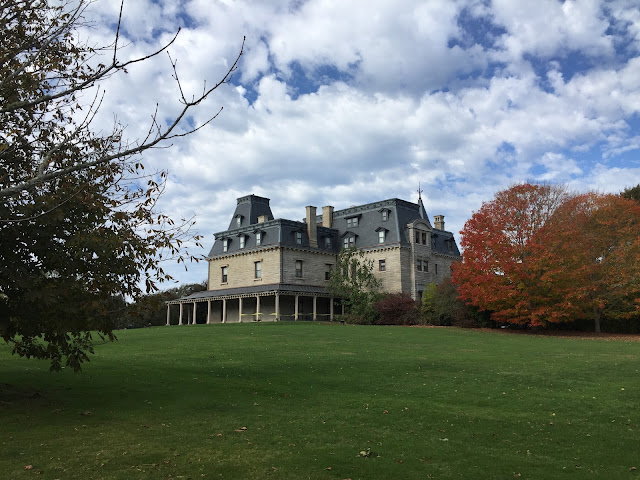 |
| A visit to Chateau-sur-Mer, now featured in Gilded Age |
The Gilded Age premiered one week ago today, and we spotted a few familiar faces as well as a few familiar edifices. In the latter category, the "cottages" of Newport -specifically, The Elms, Marble House and Chateau sur Mer - shared the stage with actors portraying fashionable New York elite of the late 19th century and the staff that supported them. With the help of this past weekend's newsletter from The Preservation Society of Newport County, I could place certain scenes with the particular cottage I visited back in 2016.
In the past, we've written about the different Newport mansions, but as a companion to the new series, we're featuring weekly snapshots of some of The Gilded Age locations we've visited and, there's no better place to start then the beginning. . . the mansion that kicked off the "grandiose cottage industry", Chateau-sur-Mer.
Chateau-sur-Mer
The main staircase of Chateau-sur-Mer is featured in the Gilded Age as part of the grand entry to Mamie Fish's home. Here, the ambitious, noveau riche, Bertha Russell delivers an invitation to Mrs. Fish, who is reportedly not in residence. Could she be hiding in one of the old mansion's elegant bedrooms?
 |
| Three story grand staircase |
 |
| Mrs. Bertha Russell finds Mamie Fish not at home |
Chateau-sur-Mer translates to "castle of the sea" and on our visit six years ago, we learned that originally the home boasted unimpeded water views. Its rich landscape once reached the ocean, but it was parceled out to other family members and beneficiaries over the years.
 |
| One of the bedrooms at Chateau-sur-Mer: a hiding place for Mrs. Fish? |
The home was built in 1852 by China trade merchant, William Wetmore. It set itself apart from other area abodes in its very size and building material. Most residences were modest structures made from lumber, whereas Chateau-sur-Mer was described as "almost palatial" and built out of granite. According to book, "Newport Mansions, The Gilded Age", it was a "turning point in domestic architecture. . . signal[ing] the beginning of the architectural competition that would keep builders busy during the last decades of the 19th century."
When William Wetmore died in 1862, the estate passed on to his son, George Peabody Wetmore, who served two terms as Governor of Rhode Island and three terms in the U.S. Senate. While working on his political career, he also wanted to rebuild his inherited mansion and turned it over to architect Richard Morris Hunt.
 |
| Chateua-sur-Mer was "remodeled" in the 1860's by William Morris Hunt |
Hunt changed the structure so much, some thought the original home was razed to start new construction. Rooms were added, doorways shifted, a roofed carriage entrance was built and a 20 by 30 foot area was gutted to create a dramatic entryway. The entrance contained a three-story hall with balconies, a skylight and an "imperial" staircase.
 |
| The entryway where both Bertha and Barbara have come to call |
Thus enters, social climber, Bertha Russell.
And, sometime after that, Chateua-sur-Mer stair climber (and tea blogger), Barbara Gulley.
 |
| Blog writer appears in dressing room mirror. |
We're looking forward to tonight's second episode! Let's see what other familiar faces or edifices we may see.



No comments:
Post a Comment